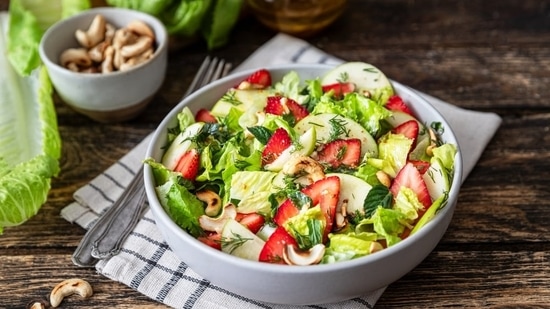French biochemist Jessie Inchauspé, popularly known as Glucose Goddess on Instagram and an NYT bestselling author, often shares her insights on the best way to avoid glucose spikes. In a post shared on August 31, she shared the easiest hack to reduce the glucose spike of your meal by up to 30 percent and produce more GLP-1 molecules.
 If there are veggies in your meal, have them at the beginning instead of the end, as it can reduce the glucose spike of your meal by up to 30%. (Shutterstock)
If there are veggies in your meal, have them at the beginning instead of the end, as it can reduce the glucose spike of your meal by up to 30%. (Shutterstock)
Also Read | NHS surgeon says ‘5g chia seeds gives 10x more fibre than 100g cucumber’; compares 22 foods: Tomato, watermelon, lentils
‘Vegetables: The real game changers’
In a video titled ‘Eat this first. It changes everything’, the biochemist revealed that eating vegetables before your meal is the easiest way to reduce post-meal glucose spikes.
Sharing the post, she wrote, “Hands down the easiest hack: If there are veggies in your meal, have them at the beginning instead of the end. This can reduce the glucose spike of your meal by up to 30%! Even though you’re eating the exact same thing. This means healthier glucose levels, fewer cravings afterwards, feeling full for longer, and more energy.”
Explaining the science behind the trick, the French biochemist highlighted how, when we eat vegetables at the beginning of our meal, three amazing things happen in our stomach and in our intestines:
How vegetables/salads reduce glucose spikes
According to the French biochemist, the fibre, from vegetables or salads, as it arrives first before all the rest of the food, has time to do these 3 things:
1. It creates a sort of viscous, protective mesh in our digestive system. She explained, “This mesh, created by the fibre, will stay in place for a few hours and prevent glucose molecules coming down from, let’s say, the pasta afterwards from arriving too quickly into our bloodstream. So, it slows down the speed of arrival of glucose in our bloodstream. That’s why we see the smaller glucose spikes.”
2. “The second effect is that fibre first slows down what’s called gastric emptying, which is simply the speed at which food moves from your stomach to your intestine. Again, this slows things down in your digestive tract,” she added.
3. Lastly, she stressed that food order has an impact on our little L-cells, and the same has been shown by several studies. She explained, “These cells are just hanging out in our digestive system; they sense when food arrives. They are in charge of creating a molecule called GLP-1.”
She added, “This molecule (GLP-1) makes us feel satiated. It makes us feel full, and it also reduces our glucose levels. Now, the studies are showing us that if we have veggies at the beginning of a meal, we can help these little cells produce more GLP-1.
Note to readers: This article is for informational purposes only and not a substitute for professional medical advice. Always seek the advice of your doctor with any questions about a medical condition.


Dining and Cooking